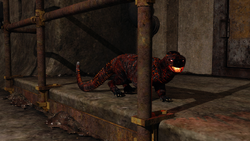Fireworm
Lanthanodrax speleotraxis.1 (Also the occasionally occuring "sport" or hypotrophic subspecies, L. speleotraxis ignigastris.)
The fireworm is possibly a candidate for the single North American species which has had its evolution most seriously interfered with by wizardry. The original species -- just another small reptile, to start with, a member of the suborder Lacertilla and a distant relative of the geckos -- was repeatedly mutated by the wizards caught up in the events surrounding the final fate of Afallonë. The most comprehensive change to their structure happened as a side effect of the great aphthonic intervention, the wizardry intended to save as much as possible of the unique Atlantean flora and fauna from the impending destruction of the First Continent. The rafting wizardry which was meant to simply transport a number of species to the newer continents went wrong during the final crisis in many important ways, and rampant wizardry leakage contaminated and disrupted the genetic structures of many of the creatures involved. The fireworm, already susceptible to such disruption because of previous genetic manipulation, suffered far more of it during the transport to the early versions of North America and Europe than any other creature involved in the ancient rafting project.
In Europe and Asia, the fireworm had fewer natural enemies, and grew and changed in ways which would otherwise have been impossible. Further mutations due to the accumulation of wizardly overlays in the more populated parts of Europe led to the rise of the offshoot species Draco, the "true dragons" which became famous in Europe's medieval period for being killed by knights. (It should be made clear that most of these casualties were members of the species Draco ectenis, the "lindworm" or wingless dragon, an omnivore by habit and cave-dweller by preference. Even the most heavily armored knights had a terrible batting average against Draco draco Europaeis, the cliff-dwelling, strictly carnivorous winged dragon, which regarded knights merely as something with a crunchy outside and a yummy inside.)
But in North America, where many "rafted" species with wizardly components survived for the next few millenia after the fall of Atlantis, the fireworm kept for some time its original Atlantean form -- that of a small carnivorous reptile with a tendency to burp flammable gas as a defense mechanism when frightened or upset. (No dragon, true or false, breathes fire: but even the smallest ones can ignite it on exhalation in one of a number of ways, usually involving chemical or enzymatic reactions.) However, unfortunately for the fireworm, its main Atlantean natural enemy the " king-weasel" (Macrogulo gulo, long since devolved into Gulo gulo, the wolverine) succeeded in establishing itself in North America as it had not been able to do in Europe because of the presence of the great crested cockatrice (Cerastus baseliensis) or northern cockatrice (Cerastus scotodasos). The king-weasel nearly succeeded in exterminating the fireworm: only the smallest members of the family survived by changing their normal above-ground habit for an underground lifestyle into which the king weasels would not follow them.
After some millennia spent living and rebuilding their gene pools in the natural caves of the East, the fireworms moved into the manufactured caves and underground spaces of the great East Coast and Midwest cities. (No fireworm species live west of the Rockies: possibly due to uncomfortable memories secondary to the fall of Afallonë, they will not stay in earthquake-active zones.) Regardless of what ConEd tells you, fireworms are the proximate cause of the steam New Yorkers see coming up from under the streets in all weathers -- the more steam, the larger the fireworm. They are some of the most exothermic of all Earth-based life forms, when well-fed, and the very biggest ones can prosper down in the tunnels in even the coldest weather. When exposed to further wizardry leakage, as sometimes happens in the neighborhood of worldgate complexes, the oldest and most experienced fireworms can over time acquire some telepathic and empathic abilities.2 This enables them to force the smaller fireworms, and even members of some other species, to do their will -- shepherding food into their ambit, or otherwise serving their needs. For this reason, smart wizards stay out of places where the older and larger fireworms can be found, unless the needs of errantry drive them there.
Fireworms are also the ultimate source of all the stories about "dragons in the sewers." There is a certain ironic humor to this, as wizards know there wouldn't be nearly so many stories if the things in the sewers were only dragons.
(See also: Eldest, the: Twelve, Song of the.) (SYWTBAW)
1The taxonomy of the western European fireworm is somewhat confused. The Bestiarium Ignotum classified the fireworm as Lanthanotrops micrognotus, but this did not take into account the internal differences between the Lanthanotrops and Lanthanodrax families -- possibly understandable, since Linnaeus was unable to find a dead specimen to dissect, and trapping a live one was at that point out of the question. The Acta Parabiologica's revised classification group places the fireworm among the various members of family Hemerothalcus, with the "true dragons" of the Lanthanodrax and Draco species.
2 Because of the already-fragile state of their DNA, such exposure over prolonged periods can also result in memory loss and other neurological problems, as seems to have been the case with the Eldest in SYWTBAW.
